Related Research Articles
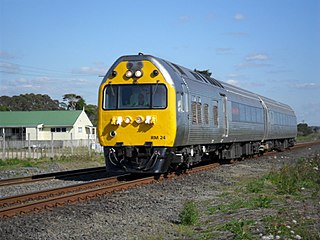
The NZR RM class Silver Fern was a class of rail motor in New Zealand. The three air-conditioned and sound-proofed 723-kW 96-seater diesel-electric twin-set railcars were built by Kawasaki under contract with Nissho Iwai of Japan. New Zealand Railways classed the railcars RM, like all other railcars.
The Silver Star was a luxury passenger train that ran overnight between Auckland and Wellington on the North Island Main Trunk (NIMT) railway of New Zealand, operated by New Zealand Railways (NZR). The train ran from Monday 6 September 1971 until Sunday 8 June 1979. It replaced the Night Limited express passenger trains which provided a faster service than the ordinary express trains, by stopping at only six intermediate stations en route and not hauling a postal traffic as previous trains had.
The Southerner was a passenger express train in New Zealand's South Island between Christchurch and Invercargill along the South Island Main Trunk, that ran from 1970 to 2002. It was one of the premier passenger trains in New Zealand and its existence made Invercargill the southernmost passenger station in the world.
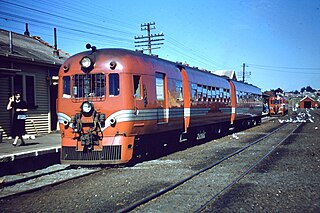
The NZR RM class 88-seaters were a class of railcar used in New Zealand. New Zealand Government Railways (NZR) classed them RM , the notation used for all railcars, numbering the 35 sets from RM100 to RM134. They were the most numerous railcars in NZR service. Their purchase and introduction saw the demise of steam-hauled provincial passenger trains and mixed trains.
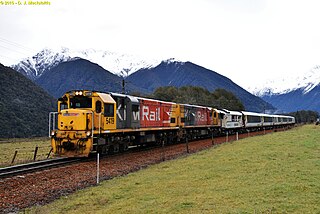
The TranzAlpine is a passenger train operated by The Great Journeys of New Zealand in the South Island of New Zealand over the Midland Line; often regarded to be one of the world's great train journeys for the scenery through which it passes. The journey is 223 kilometres (139 mi) one-way, taking almost five hours. There are 16 tunnels and four viaducts, with the Staircase Viaduct elevated as much as 75 metres (246 ft).
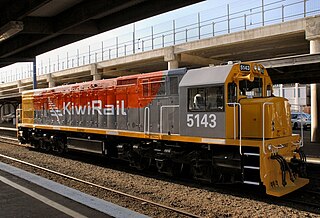
The New Zealand DX class locomotive is a type of 49 Co-Co diesel-electric locomotives that currently operate on New Zealand's national railway network. All locomotives are owned by KiwiRail.
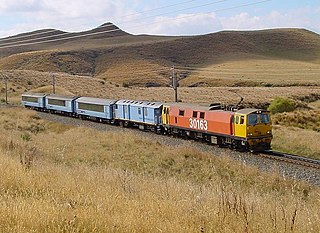
The Overlander was a long-distance rail passenger train between Auckland and Wellington in the North Island of New Zealand, along the North Island Main Trunk (NIMT). It was operated by Tranz Scenic. The service was replaced from 25 June 2012, by the Northern Explorer.
The Northerner was an overnight passenger train between Wellington and Auckland in New Zealand. The train replaced the unnamed and ordinary express trains supplementing the luxury Silver Star, which had replaced the Night Limited in 1971. The Northerner operated from 1975 to 2004.
The Bay Express was a passenger train between Wellington and Napier in New Zealand's North Island, operating from Monday, 11 December 1989 until Sunday, 7 October 2001. It was operated by New Zealand Railways Corporation's InterCity Rail division, later known as Tranz Scenic.

The Coastal Pacific is a long-distance passenger train that runs between Picton and Christchurch in the South Island of New Zealand. It is operated by The Great Journeys of New Zealand division of KiwiRail. It was called the TranzCoastal from May 2000 until temporarily withdrawn in February 2011. It was the first train to use the new AK class carriages.
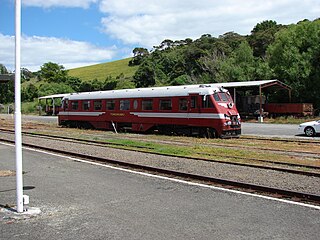
The NZR RM class Standard railcars were a class of railcar operated by the New Zealand Railways Department (NZR) in the North Island of New Zealand. Officially classified as RM like all other railcar classes in New Zealand, they acquired the designation of "Standard" to differentiate them from other railcar classes. They were introduced in 1938 and withdrawn in 1972.
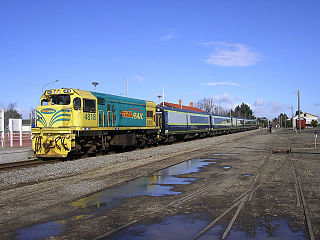
The Wairarapa Connection is a New Zealand interurban commuter rail service along the Wairarapa Line between Masterton, the largest town in the Wairarapa, and Wellington. It is operated by Wellington suburban operator Transdev under contract from the Greater Wellington Regional Council. It is a diesel-hauled carriage service, introduced by the New Zealand Railways Department in 1964 after passenger demand between Masterton to Wellington exceeded the capacity of the diesel railcars then used.

The Napier Express was a passenger express train operated by the New Zealand Railways Department initially between Napier and Palmerston North and later between Napier and Wellington. It ran from 1891 until 1954.
The Connoisseur cars were special railway carriages that were used in a number of passenger trains in New Zealand.
The Picton Express was a passenger express train operated by the New Zealand Railways Department (NZR) between Christchurch and Picton. It ran from December 1945 until February 1956, and was thus the shortest-lived provincial express in New Zealand. Following the end of railcar services in 1976, a new carriage train between Christchurch and Picton began, under the same name as the earlier service, until it was replaced in 1988 by the Coastal Pacific Express.
The New Plymouth Express was a passenger express train operated by the New Zealand Railways Department (NZR) between Wellington and New Plymouth. It ran from 1886 until 1955 and was sometimes known as the New Plymouth Mail due to the Railway Travelling Post Office carriages included in its consist. The Express was notable amongst NZR's provincial expresses as being both the first and, until the commencement of the Gisborne Express in 1942, the longest in distance travelled.
The Wairarapa Mail was a passenger train operated by the New Zealand Railways Department (NZR) between Wellington and Woodville, continuing on to Palmerston North as a mixed train. It ran from 1909 until 1948 and its route included the famous and arduous Rimutaka Incline.
The Palmerston North–Gisborne Line (PNGL) is a secondary main line railway in the North Island of New Zealand. It branches from the North Island Main Trunk at Palmerston North and runs east through the Manawatū Gorge to Woodville, where it meets the Wairarapa Line, and then proceeds to Hastings and Napier in Hawke's Bay before following the coast north to Gisborne. Construction began in 1872, but the entire line was not completed until 1942. The line crosses the runway of Gisborne Airport, one of the world's only railways to do so since Pakistan's Khyber Pass Railway closed.

The NZR 56-foot carriage is a class of 56 ft (17 m) long railway passenger carriage formerly used on almost all long-distance passenger rail transport in New Zealand. 88 carriages have been preserved.

Pahiatua railway station is on the Wairarapa Line in New Zealand’s North Island. It was opened in May 1897, shortly before the line was opened to Woodville in December of that year. The station is 1.7 kilometres (1.1 mi) from Pahiatua, in contrast to the original plans for the railway line to run through the town.
References
Citations
- 1 2 Churchman & Hurst 2001, p. 46.
- ↑ Churchman & Hurst 2001, p. 76.
- ↑ "Gisborne-Napier Passenger Service Restored". New Zealand Railway Observer. New Zealand Railway and Locomotive Society. 35: 66. Winter 1978. ISSN 0028-8624.
- ↑ "Research Notes No. 41". New Zealand Railway Observer. New Zealand Railway and Locomotive Society. 39 (171): 105. Spring 1982. ISSN 0028-8624.
- ↑ "Gisborne Express gets "AC" Cars". New Zealand Railway Observer. New Zealand Railway and Locomotive Society. 39 (174): 154. Summer 1982–83. ISSN 0028-8624.
- 1 2 Churchman & Hurst 2001, p. 144.
- 1 2 "New Zealand Railway Observer". 46 (3). New Zealand Railway and Locomotive Society. Spring 1989. p. 115. ISSN 0028-8624.
Bibliography
- Churchman, Geoffrey B; Hurst, Tony (2001) [1990, 1991]. The Railways of New Zealand: A Journey through History (Second ed.). Transpress New Zealand. ISBN 0-908876-20-3.